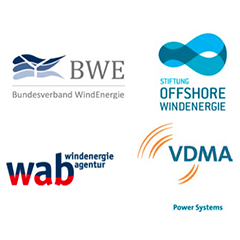Berlin, 15 January 2015 – The German market for offshore wind energy projects broke through the gigawatt barrier last year. By 31 December 2014, 258 offshore wind turbines in the German North and Baltic Seas with a total capacity of 1,049.2 megawatts fed into the grid. This figure was ascertained by Deutsche WindGuard on behalf of the four organisations VDMA Power Systems, the German Wind Energy Association (BWE), the Wind Energy Agency (WAB) and the German Offshore Wind Energy Foundation (SOW). According to the survey, 142 offshore wind turbines providing a capacity of 528.9 megawatts were newly connected to the grid. This represents more than a doubling of the capacity increase of the previous year. In addition to the grid-connected offshore wind turbines, the construction of a further 268 turbines with a capacity of 1,218.1 megawatts was completed in 2014, but these had not been fully grid-connected by the end of the year. The cumulated capacity of the 285 offshore turbines installed by the end of 2014 but not hooked up to the grid amounts to 1,303.1 megawatts. And another 220 foundations have been already put in position.
The manufacturers of offshore wind turbines, foundations and grid technology expect that the capacity increase in 2014 adds to more than just a symbolic mark. “Out at sea we have now officially broken through the gigawatt barrier for installed capacity. This corresponds to an investment volume of around 4 billion euros. In addition, turbine, foundation and grid technology exports are also in the billion-euro range. In 2015 we are expecting up to 2 gigawatts of offshore wind capacity to be newly connected to the grid. By the end of 2015, we will see a total of some 3 gigawatts installed capacity online, which corresponds to an investment of 10 billion euros in the domestic market of the German offshore wind industry”, says Norbert Giese, chairman of the VDMA steering committee for the offshore wind industry and board member of the German Offshore Wind Energy Foundation. He underlines the industrial importance of offshore wind energy “A turnover of about 1.9 billion euros had already been reached in the German offshore sector in 2013, with some 19,000 people employed in the offshore wind industry. We were able to approximately sustain these numbers in 2014.”
From the operators’ point of view, the increase in the number of installed turbines in 2014 confirms that when the revised EEG came into effect in August of last year, it triggered massive investment. “The EEG 2014 has established the framework for the scheduled expansion of the offshore wind industry, paving the way for more added value in Germany, an increase in exports, and securing jobs throughout the decade until 2020. In addition to the future EEG 3.0, it is essential that sufficient grid capacity is provided now for the period starting in 2021, which will mean investment and exports, added value and employment in Germany”, says Dr Klaus Meier, chairman of the board of WAB.
The German offshore wind industry is well positioned in the international market. “The figures we have presented show that, despite all the past challenges, we have achieved a stable growth of offshore wind capacity. The offshore technology, which has great potential for realizing the energy transition and ensuring security of supply in Germany, is on the edge of a decisive breakthrough. More than ever, a reliable legal framework is decisive for the future development. Only when investment security is ensured, it will be possible to fully exploit the cost reduction potential, maintain Germany’s leading technological position, and harness export success on a growing global market. It is therefore task of the German government to urgently provide a solid and fair legal framework for the electricity market of the future. We are convinced that 2015 will be the year of the Energiewende, the energy transition. The sector and the whole industry, as well as the federal states are ready to go”, says Hermann Albers, president of the German Wind Energy Association BWE.



























